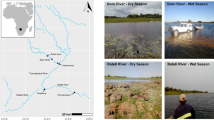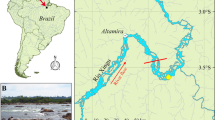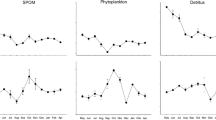Abstract
The world’s largest inland delta, located on the Okavango River in Botswana, faces major changes in the annual flooding size and duration due to climatic shifts and increased water use. We examined several parameters of a seasonal floodplain in the Okavango Delta during two years of contrasting flooding size. The small flood (2003) was characterized by high concentrations of total nutrients (2.5 mg N and 1 mg P L−1), high primary production (0.8 mg C m−3 d−1), and zooplankton biomass (30 mg DW L−1). Methane production and consumption was considerable and stable isotope analysis suggested that methane oxidation provided a significant input of C to the aquatic food web. The large flood (2004) was characterized by lower volume-specific productivity, lower concentrations of nutrients (1 mg N and 10 μg P L−1), lower primary production (45 mg C m−3 d−1), reduced zooplankton biomass (10 μg DW L−1), and low methane production. The density of fish (CPUE) was significantly higher for the large flood compared to the small one. The findings point to the overall importance of flooding size on primary and secondary production, as well as basic food web properties in the delta. Low floods mean higher volume-specific production at the base of the food web. Seasons of large and long lasting floods cause improved circulation and enhanced reproductive success for fish.
Similar content being viewed by others
Literature Cited
Alonso, L. E. and L.-A. Nordin. 2003. A Rapid Biological Assessment of the Aquatic Ecosystems of the Okavango Delta, Botswana: High Water Survey. RAP Bulletin of Biological Assessments, Conservation International, Washington, DC, USA.
Andersson, L., T. Gumbricht, D. Hughes, D. Kniveton, S. Ringrose, H. Savenije, H. Todd, J. Wilk, and P. Wolski. 2003. Water flow dynamics in the Okavango River Basin and Delta — a prerequisite for the ecosystems of the Delta. Physics and Chemistry of the Earth 28: 1165–72.
Bastviken, D., J. Ejlertson, I. Sundh, and L. Tanvik. 2003. Methane as a source of carbon and energy for lake pelagic food webs. Ecology 84: 969–81.
Bayley, P. B. 1991. The flood pulse advantage and the restoration of river-floodplain systems. Regulated Rivers 6: 75–86.
Bayley, P. B. 1995. Understanding large river-floodplain ecosystems. Bioscience 45: 153–58.
Bonyongo, M. C. and T. Mubyana. 2004. Soil nutrient status in vegetation communities of the Okavango Delta floodplains. South African Journal of Science 100: 337–40.
Bottrell, H. H., A. Duncan, Z. M. Gliwicz, E. Grygierek, A. Herzig, A. Illbricht-Ilkowska, H. Kurasawa, P. Larsson, and T. Weglenska. 1976. A review of some problems in zooplankton production studies. Norwegian Journal of Zoology 24: 419–56.
Bunn, S. E. and P. I. Boon. 1993. What sources of organic carbon drive food webs in billabongs? Oecologia 96: 85–94.
Cronberg, G., A. Gieske, E. Martins, J. Prince Nengu, and I.-M. Stenström. 1996. Major ion chemistry, plankton and bacterial assemblages of the Jao/Boro river, Okavango Delta, Botswana: the swamps and floodplains. Archiv für Hydrobiologie. Supplimentband 107: 335–407.
De Graaf, G. 2003. The flood pulse and growth of floodplain fish in Bangladesh. Fisheries Management and Ecology 10: 241–47.
Furness, H. D. and C. M. Breen. 1982. Decomposition of Cynodon dactylon (L.) Pers. in the seasonally flooded areas of the Pongolo river floodplain: pattern and significance of dry matter and nutrient loss. Hydrobiologia 97: 119–26.
Gumbricht, T., P. Wolski, P. Frost, and T. S. McCarthy. 2004. Forecasting the spatial extent of the annual flood in the Okavango delta, Botswana. Journal of Hydrology 290: 178–91.
Hart, R. C., N. A. Rayner, and H. Masundire. 2003. A brief commentary on Okavango Delta micro-Ccustacea. p. 54–58. In L. E. Alonso and L. -A. Nordin (eds.) A Rapid Biological Assessment of the Aquatic Ecosystems of the Okavango Delta, Botswana: High Water Survey. RAP Bulletin of Biological Assessments, Conservation International, Washington, DC, USA.
Hein, T., C. Baranyi, G. J. Herndl, W. Wanek, and F. Schiemer. 2003. Allochthonous and autochthonous particulate organic matter in floodplains of the River Danube: the importance of hydrological connectivity. Freshwater Biology 48: 220–32.
Hessen, D. O. and K. Nygaard. 1992. Bacterial transfer of methane and detritus; implications for the pelagic carbon budget and gaseous outputs. Archiv für Hydrobiologie, Beiheft 37: 139–48.
Hilborn, R. and C. J. Walters. 1992. Quantitative Fisheries Stock Assessment: Choice, Dynamics and Uncertainty. Chapman and Hall Publishers, New York, NY, USA.
Hocutt, C. H. and P. N. Johnson. 2001. Fish response to the annual flooding regime in the Kavango River along the Angola/Namibia border. South African Journal of Marine Sciences 23: 449–64.
Holland, M. M., P. G. Risser, and R. J. Naiman. 1991. Ecotones: the role of landscape boundaries in the management and restoration of changing environments. Chapman & Hall Publishers, New York, NY, USA.
Hollander, D. J. and M. A. Smith. 2001. Microbially mediated carbon cycling as a control on the δ13C of sedimentary carbon in eutrophic Lake Mendota (USA): new models for interpreting isotopic excursions in the sedimentary record. Geochemistry and Cosmochemistry Acta 65: 4321–37.
Høberg, P., M. Lindholm, L. Ramberg, and D. O. Hessen. 2002. Aquatic food web dynamics on a floodplain in the Okavango delta, Botswana. Hydrobiologia 470: 23–30.
Jones, R. I. and J. Grey. 2004. Stable isotope analysis of chironomid larvae from some Finnish forest lakes indicates dietary contribution from biogenic methane. Boreal Environmental Research 9: 17–23.
Junk, W. J., P. B. Bayley, and R. E. Sparks. 1989. The flood pulse concept in river-floodplain systems. p. 110–21. In D. P. Dodge (ed.) Proceedings of the International Large River Symposium. Canadian Special Publication of Fisheries and Aquatic Sciences. NRC Research Press, Ottawa, Canada.
Keckeis, S., C. Baranyi, T. Hein, C. Holarek, P. Riedleri, and F. Schiemer. 2003. The significance of zooplankton grazing in a floodplain system of the River Danube. Journal of Plankton Research 25: 243–53.
Kilham, P. 1982. The effect of hippopotamuses on potassium and phosphate ion concentrations in an African lake. American Midland Naturalist 108: 202–05.
King, M. 1995. Fisheries Biology, Assessment and Management. Blackwell Science, Oxford, UK.
Kohzu, A., C. Kato, T. Iwata, D. Kishi, M. Murakami, S. Nakano, and E. Wada. 2004. Stream food web fuelled by methane-derived carbon. Aquatic Microbial Ecology 36: 189–94.
Kolding, J. 2000. PASGEAR. A data base package for experimental or artisanal fishery data from passive gears. University of Bergen, Bergen, Norway.
Lima, I. B. T. 2005. Biogeochemical distinction of methane releases from two Amazon hydroreservoirs. Chemosphere 59: 1697–1702.
Lindholm, M. and D. O. Hessen. 2007. Zooplankton succession on seasonal floodplains: surfing on a wave of food. Hydrobiologia 592: 95–104.
Lowe-McConnell, R. H. 1979. Ecological aspects of seasonality in fishes of tropical waters. Symposium of the Zoological Society of London 44: 219–41.
Lowe-McConnell, R. H. 1987. Ecological Studies in Tropical Fish Communities. Cambridge University Press, Cambridge, UK.
Mbaiwa, J. E. 2004. Causes and possible solutions to water resource conflicts in the Okavango River Basin: the case of Angola, Namibia and Botswana. Physics and Chemistry of the Earth 29: 1319–26.
Mbongwe, B., M. Legrand, J. M. Blais, L. E. Kimpe, J. J. Ridal, and D. R. S. Lean. 2003. Dichlorodiphenyltrichloroethane in the aquatic ecosystem of the Okavango delta, Botswana, South Africa. Environmental Toxicology and Chemistry 22: 7–19.
McCarthy, J., T. Gumbricht, T. S. McCarthy, P. E. Frost, K. Wessels, and F. Seidel. 2004. Flooding patterns in the Okavango Wetland in Botswana, between 1972 and 2000. Ambio 7: 453–57.
McCarthy, T. S. and W. N. Ellery. 1998. The Okavango Delta. Transactions of the Royal Society of South Africa 53: 157–82.
McLachlan, S. M. 1971. The rate of nutrient release from grass and dung following immersion in lake water. Hydrobiologia 37: 521–30.
Mosepele, K. 2001. Description of the Okavango Delta Fishery. Report of Fisheries Section, Ministry of Agriculture, Gaborone, Botswana.
Mubyana, T., M. Krah, O. Totolo, and M. Bonyongo. 2003. Influence of seasonal flooding on soil total nitrogen, organic phosphorus and microbial populations in the Okavango Delta, Botswana. Journal of Arid Environments 54: 359–69.
Ramberg, L., P. Hancock, M. Lindholm, T. Meyer, S. Ringrose, J. Silva, J. Van As, and C. VanderPost. 2006. Species diversity of the Okavango Delta, Botswana. Aquatic Sciences 68: 310–37.
Sitaula, B. K., J. F. Luo, and L. R. Bakken. 1992. Rapid analysis of climate gases by wide bore capillary gas-chromatography. Journal of Environmental Quality 21: 493–96.
Thorp, J. H., M. D. Delong, K. S. Greenwood, and A. F. Casper. 1998. Isotopic analysis of three food web theories in constricted and floodplain regions of a large river. Oecologia 117: 551–63.
Tockner, K., F. Malard, and J. V. Ward. 2000. An extension of the flood pulse concept. Hydrological Processes 14: 2861–83.
Tockner, K., D. Pennetzdorfer, N. Reiner, F. Schiemer, and J. V. Ward. 1999. Hydrobiological connectivity, and the exchange of organic matter and nutrients in a dynamic river-floodplain system (Danube, Austria). Freshwater Biology 41: 521–35.
Tockner, K. and J. A. Stanford. 2002. Riverine flood plains: present state and future trends. Environmental Conservation 29: 308–30.
Vollenweider, R. A. (ed.). 1969. A Manual on Methods for Measuring Primary Production in Aquatic Environments. IBP Handbook 12. Blackwell Publishers, New York, NY, USA.
Welcomme, R. L. 2001. Inland Fisheries: Ecology and Management. Blackwell Science, Oxford, UK.
Whiticar, M. J. 1996. Isotope tracking of microbial methane formation and oxidation. Mitteilungen der Internationale Vereinigung fur Theoretische und Angewandte Limnologie 25: 39–54.
Wolski, P. and H. Savenije. 2006. Dynamics of floodplain-island groundwater flow in the Okavango Delta, Botswana. Journal of Hydrology 320: 283–301.
Author information
Authors and Affiliations
Rights and permissions
About this article
Cite this article
Lindholm, M., Hessen, D.O., Mosepele, K. et al. Food webs and energy fluxes on a seasonal floodplain: The influence of flood size. Wetlands 27, 775–784 (2007). https://doi.org/10.1672/0277-5212(2007)27[775:FWAEFO]2.0.CO;2
Received:
Accepted:
Issue Date:
DOI: https://doi.org/10.1672/0277-5212(2007)27[775:FWAEFO]2.0.CO;2




